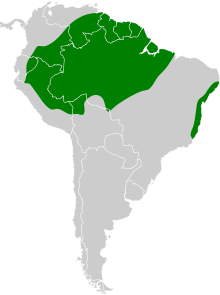Grey-crowned flatbill
| Grey-crowned flatbill[1] | |
|---|---|
 | |
| in Manaus, Brazil | |
Conservation status | |
| Scientific classification | |
| Domain: | Eukaryota |
| Kingdom: | Animalia |
| Phylum: | Chordata |
| Class: | Aves |
| Order: | Passeriformes |
| Family: | Tyrannidae |
| Genus: | Tolmomyias |
| Species: | T. poliocephalus |
| Binomial name | |
| Tolmomyias poliocephalus (Taczanowski, 1884) | |
 | |
The grey-crowned flatbill or grey-crowned flycatcher (Tolmomyias poliocephalus) is a species of bird in the family Tyrannidae. It is found in humid forest in the Amazon and Atlantic Forest in South America. It closely resembles the yellow-margined and yellow-olive flatbills, but its lower mandible is dark with a pale base. It is a fairly common bird with a wide range and the International Union for Conservation of Nature has rated it as "least concern".

Description
Tolmomyias flatbills are robust small birds with broad beaks. The grey-crowned flatbill is about 12 cm (4.7 in) long and has a generally yellowish-green plumage, a grey cap and nape, and a yellowish throat marked with grey. The iris is usually a pale colour and the mandible has a dark tip. Several species of flatbill overlap in their range and are easily confused with each other visually, but their songs are mostly distinctive. The grey-crowned flatbill's song is a series of whistles rising in pitch with the final whistle trembling – "tuee? tuee? TUEE? tuEEuEE? tuEEuEE?". The only other similar song in the genus is that of the yellow-margined flatbill (Tolmomyias assimilis) which has a more rasping quality;[3] flatbills in this genus are difficult to tell apart and the voice is usually the best means of recognition.[4] The stance of this species is more horizontal than other members of the genus, and it sometimes cocks its tail.[4]
Distribution and habitat
The grey-crowned flatbill is native to the Amazon region of South America. Its range includes Bolivia, Brazil, Colombia, Ecuador, French Guiana, Guyana, Peru, Suriname and Venezuela.[2] Its maximum altitudinal range extends to 1,000 m (3,300 ft) or locally higher. It generally inhabits the middle and upper canopy of the rainforest as well as forest edges, river valleys and tall secondary forest growth.[3] The nest is shaped like a bag and has a tubular entrance near the base; it is often hung near a wasp nest.[4]
Status
The grey-crowned flatbill has a very wide range in the Amazon rainforest and on the lower slopes on the eastern side of the Andes. It is said to be a fairly common species and its population trend may be declining slightly but not at a rate that would cause concern, and the International Union for Conservation of Nature has assessed its conservation status as being of "least concern".[2]
References
- ^ Gill, F., Wright, M. & Donsker, D. (2009). IOC World Bird Names (version 2.2). Available at http://www.worldbirdnames.org/ Accessed 30 August 2009
- ^ a b c BirdLife International (2016). "Tolmomyias poliocephalus". IUCN Red List of Threatened Species. 2016: e.T22699615A93739834. doi:10.2305/IUCN.UK.2016-3.RLTS.T22699615A93739834.en. Retrieved 12 November 2021.
- ^ a b Schulenberg, Thomas S.; Stotz, Douglas F.; Lane, Daniel F.; O'Neill, John P.; Parker, Theodore A. III (2010). Birds of Peru. Princeton University Press. p. 438. ISBN 978-1-4008-3449-5.
- ^ a b c Ridgely, Robert S.; Tudor, Guy (2009). Field Guide to the Songbirds of South America: The Passerines. University of Texas Press. pp. 240–242. ISBN 978-0-292-71748-0.
External links
- Xeno-canto: audio recordings of the grey-crowned flatbill
 Data related to Tolmomyias poliocephalus at Wikispecies
Data related to Tolmomyias poliocephalus at Wikispecies
- v
- t
- e
- Archaeopteryx
- Omnivoropterygiformes
- Jeholornithidae
- Confuciusornithiformes
- Enantiornithes
- Chaoyangiformes
- Patagopterygiformes
- Ambiortiformes
- Songlingornithiformes
- Hongshanornithidae
- Gansuiformes
- Ichthyornithiformes
- Hesperornithes
- Lithornithiformes
- Dinornithiformes
- Aepyornithiformes
- Gastornithiformes
interaction
| |||||||||||||||||||||||||||||||||||||||||||||||||||||||||||||||||
 Category
Category Commons
Commons Portal
Portal WikiProject
WikiProject















